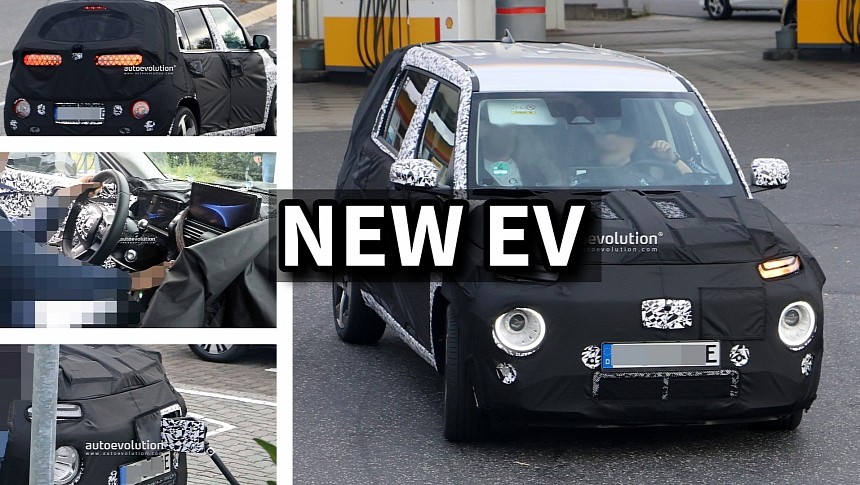Two years ago, Hyundai pulled the covers off a new city car in its home market. Christened the Casper, apparently after a skateboarding technique, it is the brand's smallest vehicle currently on sale. And we wouldn't have dedicated an entire story to it if it hadn't been spied testing in Europe.
The Hyundai Casper is offered with two gasoline engines in Korea. The naturally aspirated 1.0-liter unit produces 75 hp (76 ps/56 kW), and the turbocharged 1.0L mill is good for 99 hp (100 ps/74 kW). Both are paired with a four-speed automatic transmission and front-wheel drive.
If the latest data is correct, then they will be joined by a BEV derivative. In 2022, the Korean automaker announced the development of a tiny electric vehicle for Europe. And given that the Casper was spotted putting its zero-emission powertrain to use in the Old Continent recently, it probably means that this is the model that is coming to the right side of the Atlantic Ocean.
Although hard, it is not impossible to make out the differences between the ICE-powered Hyundai Caspers and the electric prototype. The camouflaged tester has a new front bumper with a presumably smaller central intake and a redesigned grille. The rear bumper was also reshaped. It appears that the dual lighting signature up front will soldier on, and the same goes for the taillights, as well. The wheels are different, and together with the low-friction tires, they will improve the range of the electric city car.
A quick look inside reveals that there are no apparent modifications. No major ones, anyway, as the two tablet-like screens, the infotainment system and digital cluster, likely feature new software. Instead of a two-spoke steering wheel, the battery-electric tester, whose charging port can be seen in the front bumper, has a three-spoke unit. Additional novelties could come in the shape of a tweaked center console and perhaps new upholstery to further differentiate it from the models powered by gasoline.
Logic dictates that the all-quiet Casper will be put together on the same assembly lines as its siblings that use internal combustion engines, as the brand's factory in Gwangju, South Korea. The normal Casper shares many nuts and bolts with the Hyundai i10 and Kia Picanto, and so will the battery-electric variant, as it will use the same platform.
It is too early to speak about the powertrain, battery pack, and targeted range, but we can tell you that the base version of the tiny EV has a targeted starting price of just under €20,000 (equal to approximately $21,400) in Europe. More details will be released as the testing phase advances, and everything will unravel during the grand unveiling, presumably sometime next year.
If the latest data is correct, then they will be joined by a BEV derivative. In 2022, the Korean automaker announced the development of a tiny electric vehicle for Europe. And given that the Casper was spotted putting its zero-emission powertrain to use in the Old Continent recently, it probably means that this is the model that is coming to the right side of the Atlantic Ocean.
Although hard, it is not impossible to make out the differences between the ICE-powered Hyundai Caspers and the electric prototype. The camouflaged tester has a new front bumper with a presumably smaller central intake and a redesigned grille. The rear bumper was also reshaped. It appears that the dual lighting signature up front will soldier on, and the same goes for the taillights, as well. The wheels are different, and together with the low-friction tires, they will improve the range of the electric city car.
A quick look inside reveals that there are no apparent modifications. No major ones, anyway, as the two tablet-like screens, the infotainment system and digital cluster, likely feature new software. Instead of a two-spoke steering wheel, the battery-electric tester, whose charging port can be seen in the front bumper, has a three-spoke unit. Additional novelties could come in the shape of a tweaked center console and perhaps new upholstery to further differentiate it from the models powered by gasoline.
Logic dictates that the all-quiet Casper will be put together on the same assembly lines as its siblings that use internal combustion engines, as the brand's factory in Gwangju, South Korea. The normal Casper shares many nuts and bolts with the Hyundai i10 and Kia Picanto, and so will the battery-electric variant, as it will use the same platform.
It is too early to speak about the powertrain, battery pack, and targeted range, but we can tell you that the base version of the tiny EV has a targeted starting price of just under €20,000 (equal to approximately $21,400) in Europe. More details will be released as the testing phase advances, and everything will unravel during the grand unveiling, presumably sometime next year.





























